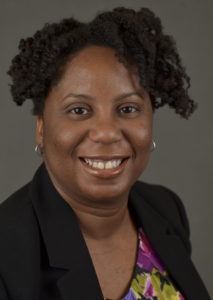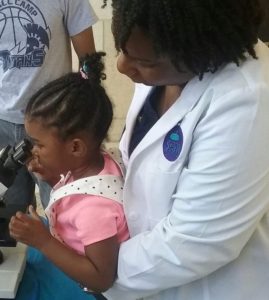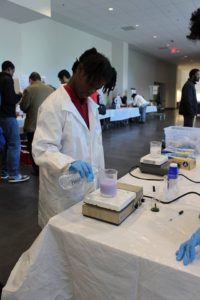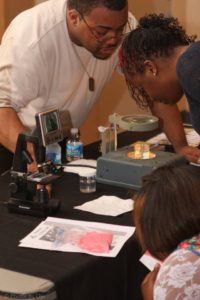 One of the goals of the Big Words Blog Site is advocacy of Science, Technology, Engineering and Mathematics (STEM) awareness for under-represented minorities, and starting discussions about increasing access. I personally try to get involved in these types of efforts whenever my schedule permits it. In the fall of 2016, I assisted Dr. Vernon Morris and his team from Howard University’s NOAA Center for Atmospheric Sciences (NCAS) at the Science, Engineering and Mathematics Link’s (SEM Link) First Annual DC, Maryland and Virginia (DMV) STEM Career Fair. Recently I had the opportunity to interview the Founder and Executive Director of SEM Link, Tokiwa Smith. We discussed the organization, its inception and goals, and the current challenges of exposing under-represented minorities to STEM education which would lead to their ascension into these careers.
One of the goals of the Big Words Blog Site is advocacy of Science, Technology, Engineering and Mathematics (STEM) awareness for under-represented minorities, and starting discussions about increasing access. I personally try to get involved in these types of efforts whenever my schedule permits it. In the fall of 2016, I assisted Dr. Vernon Morris and his team from Howard University’s NOAA Center for Atmospheric Sciences (NCAS) at the Science, Engineering and Mathematics Link’s (SEM Link) First Annual DC, Maryland and Virginia (DMV) STEM Career Fair. Recently I had the opportunity to interview the Founder and Executive Director of SEM Link, Tokiwa Smith. We discussed the organization, its inception and goals, and the current challenges of exposing under-represented minorities to STEM education which would lead to their ascension into these careers.
Anwar Dunbar: First off Tokiwa, thank you for agreeing to talk about your background and very important for individuals from our backgrounds to openly discuss our careers and how we got to where we are. With that said, let’s start with you. Talk about your background.
Tokiwa Smith: I have a Bachelor’s of Science Degree in Chemical Engineering from Florida A & M University. I’ve used my STEM degree to help inspire and train future STEM professionals – pre-college and undergraduate students – through my work at various academic institutions, non-profit organizations and government agencies.
AD: Most of my African American peers in STEM had a mentor (myself included), someone who recognized their potential and encouraged them to pursue a STEM career. Was there a mentor or mentors along the way who encouraged you to study Chemical Engineering, or were you always interested in that discipline?
 TS: Even though I grew up in a college educated family and most of the adults in the village that raised me were college educated, there were no STEM professionals in my network, other than my aunt who was a Microbiologist for the Food and Drug Administration. I was a girl who always loved and excelled in math and science. My 6th grade teacher, Mrs. Richardson, noticed my aptitude for math and science and told my mother to encourage me in those subjects. So throughout my formative years, I was encouraged by my mother and my teachers to excel in math and science. I thus always had confidence in my abilities in STEM. It was in 10th grade, in Mrs. Shy’s chemistry class, that I discovered my favorite STEM discipline was chemistry. In 11th grade as I was getting tutored in physics by a friend’s father who was a Cosmetic Chemist, and I discovered that I didn’t want to be a chemist. I did some research and learned about chemical engineering. I decided to major in Chemical Engineering because it combined my love of chemistry and math.
TS: Even though I grew up in a college educated family and most of the adults in the village that raised me were college educated, there were no STEM professionals in my network, other than my aunt who was a Microbiologist for the Food and Drug Administration. I was a girl who always loved and excelled in math and science. My 6th grade teacher, Mrs. Richardson, noticed my aptitude for math and science and told my mother to encourage me in those subjects. So throughout my formative years, I was encouraged by my mother and my teachers to excel in math and science. I thus always had confidence in my abilities in STEM. It was in 10th grade, in Mrs. Shy’s chemistry class, that I discovered my favorite STEM discipline was chemistry. In 11th grade as I was getting tutored in physics by a friend’s father who was a Cosmetic Chemist, and I discovered that I didn’t want to be a chemist. I did some research and learned about chemical engineering. I decided to major in Chemical Engineering because it combined my love of chemistry and math.
I didn’t meet a female African American Chemical Engineer until my sophomore year in college. The following year I took my first class with professor Dr. G. Dale Wesson, the only African American professor in the department. I was further exposed to Chemical Engineering through his mentorship and his taking me to my first STEM professional conference. At that conference I was able to meet a myriad of people – students from other colleges and universities, and STEM professionals who made me aware of the possibilities for career options that I could pursue with a Chemical Engineering degree.
AD: What is SEM Link and how did you start it? Why did you start it?
 TS: Science, Engineering and Mathematics Link, Inc. (SEM Link) is a tax-exempt national nonprofit organization, which I founded in 2005 in Atlanta, GA, on the premise that exposure to members of the STEM communities is critical to student achievement and career exploration in math and science. Our programs and events enhance the STEM educational experience for K-12 students by providing them with opportunities to engage in hands-on STEM activities, exploration of STEM careers and learning about real-world applications of STEM in their classrooms and communities.
TS: Science, Engineering and Mathematics Link, Inc. (SEM Link) is a tax-exempt national nonprofit organization, which I founded in 2005 in Atlanta, GA, on the premise that exposure to members of the STEM communities is critical to student achievement and career exploration in math and science. Our programs and events enhance the STEM educational experience for K-12 students by providing them with opportunities to engage in hands-on STEM activities, exploration of STEM careers and learning about real-world applications of STEM in their classrooms and communities.
The idea to start SEM Link came to me in 2002 while working at a school in Atlanta. I saw many brilliant students who had the aptitude to pursue STEM careers, but weren’t considering them because they didn’t know any adults who were STEM professionals. I had people in my network that I started inviting to the school for various activities (career exploration activities and tutoring, etc.) to provide opportunities for students to meet and interact with STEM professionals.
 In 2005, I decided to create a nonprofit organization to expose more youth to STEM education and careers; specifically to provide opportunities for them to meet and interact with STEM professionals and to engage in hands-on STEM activities. I chose the name Science, Engineering and Mathematics Link (SEM Link) because, at the time, there was no focus on technology (T). I wanted the organization to be the link (connection) between K-12 students and the STEM community. Our vision statement is, “Unveiling potential through exposure,” because the inaugural Board of Directors and I thought it best described the vision that we had and the work that we wanted to do as an organization. We could help create the pipeline for the future STEM workforce by exposing youth to STEM education and careers.
In 2005, I decided to create a nonprofit organization to expose more youth to STEM education and careers; specifically to provide opportunities for them to meet and interact with STEM professionals and to engage in hands-on STEM activities. I chose the name Science, Engineering and Mathematics Link (SEM Link) because, at the time, there was no focus on technology (T). I wanted the organization to be the link (connection) between K-12 students and the STEM community. Our vision statement is, “Unveiling potential through exposure,” because the inaugural Board of Directors and I thought it best described the vision that we had and the work that we wanted to do as an organization. We could help create the pipeline for the future STEM workforce by exposing youth to STEM education and careers.
AD: What are you goals for SEM Link?
TS: SEM Link currently serves two urban areas, Atlanta and the DMV. It is our goal within the next five to seven years to expand to six additional areas. The urban areas we are looking at expanding to include: Chicago, Dallas, Miami and other urban areas on the east coast, in the south and midwest. In addition, we are in the process of transitioning from a startup phase to a sustainability phase. The process includes recruiting new members to the Board of Directors, increasing the number of individual donors, building and maintaining relationships with corporate partners, and starting a major gifts program in the next fiscal year.
AD: What are the challenges in getting under-represented minorities involved in STEM?
 TS: Minorities, especially African Americans, come from cultures that have had scientists, engineers, mathematicians and inventors dating back to Ancient African civilizations. African Americans have continued throughout history and today to make an impact in the STEM fields as professionals and inventors. The first challenge to me is representation; minorities don’t see enough folks that look like them who are STEM professionals. Students aren’t told enough of the stories of the successes of former and current minority STEM professionals. They aren’t exposed often enough to opportunities for them to meet and interact with STEM professionals of color.
TS: Minorities, especially African Americans, come from cultures that have had scientists, engineers, mathematicians and inventors dating back to Ancient African civilizations. African Americans have continued throughout history and today to make an impact in the STEM fields as professionals and inventors. The first challenge to me is representation; minorities don’t see enough folks that look like them who are STEM professionals. Students aren’t told enough of the stories of the successes of former and current minority STEM professionals. They aren’t exposed often enough to opportunities for them to meet and interact with STEM professionals of color.
The second challenge is that students don’t get an opportunity to engage enough in hands-on STEM activities inside the classroom and during out of school time. Although it’s important for students to learn and master STEM concepts and theories, it isn’t limited to a textbook. It’s hands-on and it asks and answers questions that we may or may not already have the answers to.
The final challenge is that at times we only encourage the “smart” kids to pursue STEM careers. There are children that have a natural inclination towards STEM and you can observe it based on their interests and how they play. For example, a kid that collects insects for fun has a natural inclination to be a biologist even if they may have academic deficiencies in school. We should also encourage those kids to pursue STEM careers and provide them with the academic support they need to overcome those deficiencies and excel academically.
AD: That’s interesting. I can confirm the lack of STEM role models. In my youth in Buffalo, NY, I don’t remember seeing any STEM professionals of color. Biology was my favorite course and I just naturally followed it.
In terms of being careful not to only focus on the “smart” kids, one of the things my father, a retired science teacher, told us once was that individuals who grow up in inner cities and substandard conditions are actually very creative and inventive out of necessity. Malcolm X also discussed this in his autobiography regarding the wasted intellectual talent in our inner cities.
I was talking to a fellow toxicologist about how it’s more difficult to give students a good look at parts of the biological sciences because you have to take them to research centers to see the experiments being performed versus computers, cell phones and designing apps and video games – the more “techie-stuff”. Have you found that students seem to flock towards one more than the other?
 TS: I think the reason that kids are flocking towards techie stuff is because of the current trend to push teaching all kids to code. The reality is not all kids have the ability or are interested in coding and tech. However, coding and tech are easy to push because it is something that the general public can understand because, unlike other STEM disciplines, they can easily see the connections to their everyday lives. Those of us that work in other STEM disciplines must do a better job of telling the stories of what we do as STEM professionals and help the general public to see the connections between STEM disciplines and their everyday lives.
TS: I think the reason that kids are flocking towards techie stuff is because of the current trend to push teaching all kids to code. The reality is not all kids have the ability or are interested in coding and tech. However, coding and tech are easy to push because it is something that the general public can understand because, unlike other STEM disciplines, they can easily see the connections to their everyday lives. Those of us that work in other STEM disciplines must do a better job of telling the stories of what we do as STEM professionals and help the general public to see the connections between STEM disciplines and their everyday lives.
I disagree that the only way to expose kids is to take them to places where professionals in engineering, biological and physical sciences work. Although that would be nice and it is a great experience for the students, it isn’t always feasible. Kids make decisions on what they will become when they grow up based on the careers of the adults in their lives; even people that they may meet only once. A child meeting a STEM professional one time and learning what is possible for them can change the entire trajectory of their lives. So the first step is for STEM professionals to get out of their workplace and go to where the kids are – schools, community events, etc. – and talk to the kids about what you do, why you do it and your career path to get there.
The second thing is to talk to kids about how your fields connect to their everyday lives. For example, a toxicologist can talk to students about things like lead poisoning and how it can be detected in one’s body. The final thing is that STEM professionals can engage students in hands-on and/or project based activities that can expose the students to their field.
AD: Well, Tokiwa, those are all of the questions that I have. Do you have any parting comments? Would you like to tell the readers how they can learn more about SEM Link, and where they can contact you, on Twitter for example?
 TS: My parting comment is the keys to getting kids interested in pursuing STEM are encouragement and exposure. We must encourage students to engage in activities in the STEM disciplines for which they show an aptitude and passion. We also must encourage students to engage in out of school activities – doing hands-on STEM activities on their own. We must expose them to as many STEM disciplines and out of school time activities as we can. As adults, we must be willing to step outside of our comfort zone and sometimes go against the trends. If we do these things, we will allow our children to discover a passion and aptitude to pursue STEM careers.
TS: My parting comment is the keys to getting kids interested in pursuing STEM are encouragement and exposure. We must encourage students to engage in activities in the STEM disciplines for which they show an aptitude and passion. We also must encourage students to engage in out of school activities – doing hands-on STEM activities on their own. We must expose them to as many STEM disciplines and out of school time activities as we can. As adults, we must be willing to step outside of our comfort zone and sometimes go against the trends. If we do these things, we will allow our children to discover a passion and aptitude to pursue STEM careers.
 To find more information about SEM Link, you can visit our website at: www.semsuccess.org, and sign up for our mailing list. You can follow us on social media as well. Our Twitter handle is @semlink. We are also on Facebook and Instagram. Lastly, you can connect with me on Twitter. My Twitter handle is @tokiwana.
To find more information about SEM Link, you can visit our website at: www.semsuccess.org, and sign up for our mailing list. You can follow us on social media as well. Our Twitter handle is @semlink. We are also on Facebook and Instagram. Lastly, you can connect with me on Twitter. My Twitter handle is @tokiwana.
AD: Well thank you, Tokiwa, once again for your willingness to discuss SEM Link. It’s very important work and myself and others look forward to seeing your effort grow. Also thank you for providing the pictures used in this piece.
Thank you for taking the time to read this interview. If this interview, you might also enjoy
• Dr. Quin Capers, IV discusses his path #BlackMenInMedicine, and the present landscape of medical education
• Dr. Namandje Bumpus discusses her educational path, and her research career in Pharmacology
• A Black History Month interview with Howard University’s Dr. Vernon Morris part one
• A Black History Month interview with Howard University’s Dr. Vernon Morris part two
If you’ve found value here and think it would benefit others, please share it and or leave a comment. To receive all of the most up to date content from the Big Words Blog Site, subscribe using the subscription box in the right hand column in this post and throughout the site. Lastly follow me on Big Words Blog Site Facebook page, on Twitter at @BWArePowerful, and finally on Instagram at @anwaryusef76. While my main areas of focus are Education, STEM and Financial Literacy, there are other blogs/sites I endorse which can be found on that particular page of my site.

This is one of the best interviews so far and another great read! Your interview seemed to capture Tokiwa Smith’s passion and enthusiasm for STEM. Readers will visit her site. I did. It would be great to learn about summer STEM opportunities via a link. It is time for summer camp registration. Thanks Dr. Dunbar for an excellent piece that will motivate parents, teachers and mentors to support STEM interest in our communities.
Thank you for your comment S. Joseph. I really appreciate your taking the time to give your insight. Yes I truly believe exposure and empowerment are the keys when it comes to STEM education. Scientists like Tokiwa are so important because many students don’t have STEM professionals in their families and need to see scientists who look like them walking the walk and talking the talk.
This is a very informative article which should be read by all educators of the sciences, as well as students and parents. There is so much talent in our young people that needs the opportunity to be exposed. Please continue to get the word out. Thank you.
Thank you for your comment Ms. Anderson. You are correct. Many kids of color have the ability to do and excel at science, but they lack the exposure or someone to tell them that they can do it. That makes a huge difference.